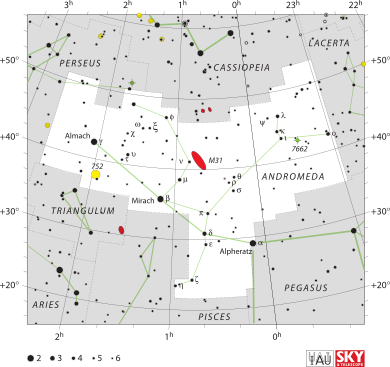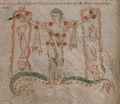Andromeda (constellation) facts for kids
| Constellation | |

List of stars in Andromeda
|
|
| Abbreviation | And |
|---|---|
| Genitive | Andromedae |
| Pronunciation | genitive |
| Symbolism | Andromeda, the Woman Chained |
| Right ascension | 1 |
| Declination | +40 |
| Quadrant | NQ1 |
| Area | 722 sq. deg. (19th) |
| Main stars | 4, 18 |
| Bayer/Flamsteed stars |
65 |
| Stars with planets | 8 |
| Stars brighter than 3.00m | 3 |
| Stars within 10.00 pc (32.62 ly) | 3 |
| Brightest star | α And (Alpheratz) (2.07m) |
| Messier objects | 3 |
| Meteor showers | Andromedids (Bielids) |
| Bordering constellations |
Perseus Cassiopeia Lacerta Pegasus Pisces Triangulum |
| Visible at latitudes between +90° and −40°. Best visible at 21:00 (9 p.m.) during the month of November. |
|
Andromeda is a well-known constellation found in the northern part of the night sky. It gets its name from Princess Andromeda in ancient Greek mythology. People sometimes call it "the Chained Woman" because of her story.
The famous Andromeda Galaxy is located within this constellation. It is the closest large spiral galaxy to our own Milky Way. It's about 2.2 million light-years away from Earth. The brightest star in Andromeda is called Alpha Andromedae, also known as Alpheratz. It is actually a binary star, meaning it's made of two stars orbiting each other.
| Top - 0-9 A B C D E F G H I J K L M N O P Q R S T U V W X Y Z |
Discovering the Andromeda Constellation
Andromeda is one of the 88 constellations recognized by the International Astronomical Union. It was first listed by the astronomer Ptolemy way back in the 2nd century. This makes it one of the oldest known constellations.
The Story of Princess Andromeda
The constellation is named after Princess Andromeda from Greek myths. She was the daughter of King Cepheus and Queen Cassiopeia. Her mother, Cassiopeia, boasted that she was more beautiful than the sea nymphs. This angered the sea god Poseidon.
To punish the kingdom, Poseidon sent a sea monster named Cetus. To save her people, Andromeda was chained to a rock as a sacrifice to the monster. Luckily, the hero Perseus rescued her. He later married Andromeda.
Finding Andromeda in the Night Sky
Andromeda is easy to spot in the autumn sky in the Northern Hemisphere. It looks like a long chain of stars. You can find it near other constellations like Pegasus, Cassiopeia, and Perseus.
One way to find it is to look for the Great Square of Pegasus. Andromeda stretches out from one of the corners of this square.
Stars and Galaxies in Andromeda
Andromeda is home to many interesting stars and deep-sky objects. It's a great place for stargazers to explore with a telescope.
Alpheratz: The Brightest Star
The brightest star in Andromeda is called Alpha Andromedae, or Alpheratz. It shines with a magnitude of about 2.07. This star is special because it's not just one star, but two stars orbiting each other.
Alpheratz is also part of the Great Square of Pegasus. It marks the head of Andromeda in some star maps.
The Andromeda Galaxy: Our Cosmic Neighbor
The most famous object in the Andromeda constellation is the Andromeda Galaxy (also known as M31). It's a huge spiral galaxy similar to our own Milky Way. It's so big and bright that you can sometimes see it with your bare eyes on a clear, dark night. It looks like a faint, fuzzy patch of light.
Scientists believe that the Andromeda Galaxy and the Milky Way are on a collision course. But don't worry, this won't happen for billions of years! When they do meet, they will likely merge to form an even larger galaxy.
Other Cool Objects to See
Besides the Andromeda Galaxy, there are other cool things in this constellation:
- Messier 32 (M32) and Messier 110 (M110): These are smaller galaxies that orbit the Andromeda Galaxy.
- The Blue Snowball Nebula (NGC 7662): This is a planetary nebula. It's a cloud of gas and dust that forms when a star like our Sun reaches the end of its life. It looks like a small, blue-green ball through a telescope.
Images for kids
-
Johannes Hevelius's drawing of Andromeda from 1690.
-
A Hertzsprung–Russell diagram for bright stars in Andromeda.
-
The Blue Snowball Nebula as seen through the Hubble Space Telescope.
See also
 In Spanish: Andrómeda (constelación) para niños
In Spanish: Andrómeda (constelación) para niños








